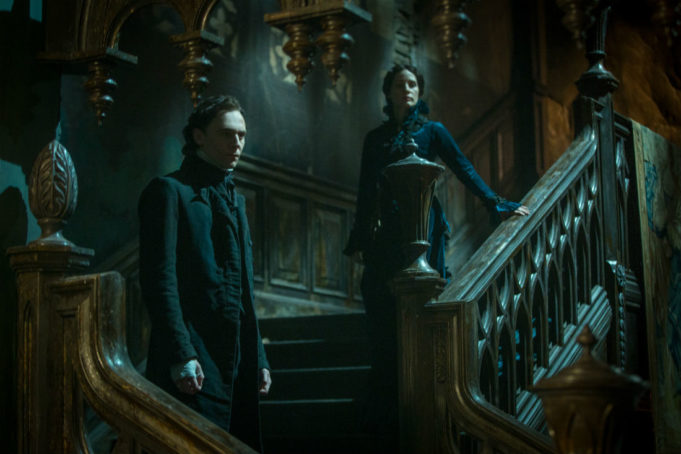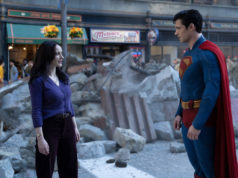Ever since I heard about the existence of Crimson Peak, I’ve been holding my breath waiting for it. The draw of a horror movie directed by Guillermo Del Toro would have been enough to interest me, but I have a special affection for the classic English ghost stories that this piece is obviously inspired by. The film didn’t screen in time for me to get a review into our print issue, but I’m blogging about it now because it’s the most gorgeous thing I’ve seen all year.
The movie is set at an unspecified time during the early 20th century — the characters have primitive cars and phonograph machines. Edith Cushing (Mia Wasikowska) is a Buffalo heiress who wants to write novels. Sir Thomas Sharpe (Tom Hiddleston) is a financially struggling English baronet who visits Edith’s father (Jim Beaver) to raise capital so he can resurrect the clay mines on his estate in Cumberland. That proves to be unsuccessful, but Edith falls for him and marries him. She’s already seeing ghosts before she leaves upstate New York, but it intensifies after she moves in with Sir Thomas’ and his icy sister Lucille (Jessica Chastain) at their remote, grand, decrepit mansion, Allerdale Hall.
Del Toro’s movies are always beautiful, but even he has never surpassed this. Only Pan’s Labyrinth rivals this film for sheer visual beauty in his body of work. During the American parts of this story, the movie (photographed by Dan Laustsen, whose middling career up to this point has included The League of Extraordinary Gentlemen and the movie version of Silent Hill) goes in for a burnished look, with lots of burgundies, maroons, browns, and golds. When it gets to England, its color palette goes full-on Hammer Studios, with supersaturated reds, inky blacks, and ghostly whites. The hole in Allerdale Hall’s roof allows for snow to fall inside the house’s well-like foyer and fly around the corridors, which is an innovative touch for a haunted-house movie. The red clay that the Sharpe estate is built on forms a great backdrop for the action, especially during the climactic sequence that takes place against a “crimson peak,” when the clay stains the snow red and it looks like the entire landscape is bleeding. You can tell this is a Del Toro movie from his signature motifs: insects, keys and locks, old books, mechanical gadgets. The balance of flamboyant visuals and restrained camera movement is very reminiscent of those old Hammer movies, but Crimson Peak also reminds me of Martin Scorsese’s 1993 film The Age of Innocence, which is set during a similar time period and uses silent-film-style irises to focus our attention on a single part of the screen. (The Age of Innocence is also quite an effective horror film.)
I can hear the horror fans saying, “Enough about this! We don’t like to look at stuff! How scary is this movie?” Here’s where it falls just short. The director takes this at a relatively leisurely pace, which is also in keeping with the spirit of Hammer. The British studio had its heyday in the 1960s and favored visual beauty, character development, and lurid sexuality over gore. (It was most famous for its Dracula movies starring the late Christopher Lee.) Del Toro’s movie has its share of gore, if that’s what turns you on, but he and co-writer Matthew Robbins could have handled the characters and suspense better. Sir Thomas and Lucille are sketchy from the off and clearly after Edith’s money, and I guessed the deep, dark Sharpe family secret back when I saw this movie’s trailer. (In the movie’s defense, the secret makes psychological sense, and I made a clever guess.) The ghosts that haunt Edith are played by Doug Jones, the American mime actor who worked for Del Toro as Abe Sapien in the Hellboy movies and both the faun and the pale man in Pan’s Labyrinth. He lends his flair for grotesque movement to the spirits. Still, I was looking to this to possibly depose It Follows as the year’s best horror movie, and it doesn’t.
The trump card is Chastain. I’ve always admired this actress’ performances without ever truly liking them, but holy hell, she’s scary in this thing. Not overly tall, she nevertheless draws herself up to her full height here and makes herself look big and imposing. She may be channeling Judith Anderson’s Mrs. Danvers from Hitchcock’s Rebecca, but she’s no less effective for that, and she is harrowing in a scene when Lucille does nothing more than talk about her mother while feeding porridge to an ill Edith. (Del Toro and his audio designers help her out by making the spoon’s underside scraping against the bowl’s edge sound like the grinding of industrial machinery.) She’s spectacular when the repressed Lucille comes unglued, like in an early moment with a frying pan and during the climax. She creates a villain who’s fully aware that she’s been twisted into monstrosity by two awful parents and a childhood spent in isolation. Wasikowska makes a personable heroine against her, but it’s a pitiable and terrifying Chastain who’ll haunt your nightmares.
As a pianist, I must point out that Chastain is not, in fact, playing the last notes of Chopin’s Ballade No. 1 during the party sequence near the beginning. Anyway, this Gothic horror piece plays like “The Fall of the House of Usher” reimagined by some steampunk-inflected genius. That describes Guillermo Del Toro pretty well, and the Mexican master has given us a superbly stylish bit of entertainment for the Halloween season.












